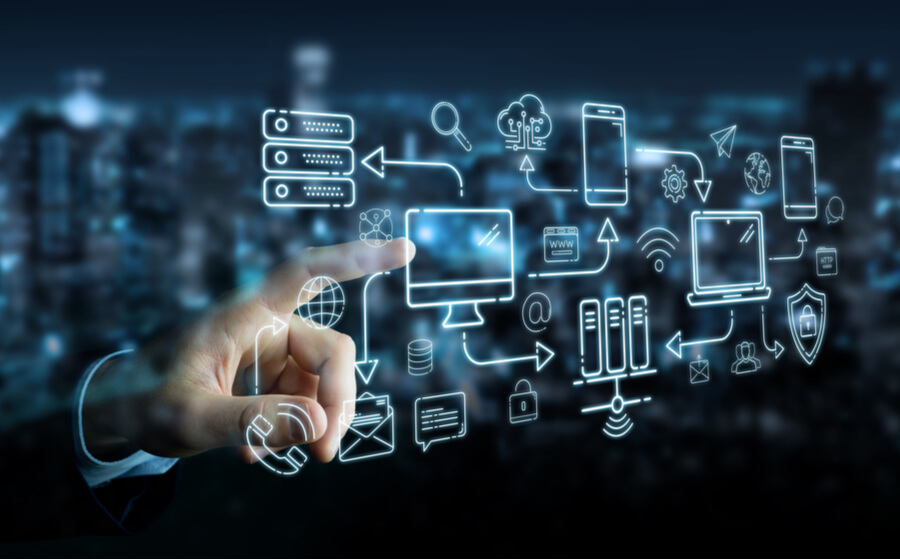People have been designing and creating technologies for generations over time. These technologies have been used to find and solve problems that people face all over the world.
Digital technologies are not just about being able to use a computer, a phone or a tablet. Digital technologies are about understanding how these technologies were imagined, created and used. Digital technologies involve using computational thinking to come up with creative solutions that could lead to efficient ways of doing things.

“The final frontier of Digital Technology is integrating into your own brain!”
Digital technologies are becoming increasingly imperative in everyday life- from laser to Artificial intelligence, from image processing to Big data. These technologies are layered upon one another, adding new functionalities on top of others.
Digital technology is integrating technology to deliver value to businesses and customers. They stand behind the applications thus, changing the way we live, work and communicate with others.
The era of the digital revolution:
We are living in exponential times. Let’s explicate this revolution by pondering upon a few facts:
- There are around 100 billion searches on Google every month; In 2006, the number being 2.7 billion.
- The first commercial text message was sent in December of 1992. Today, the number of text messages sent and received every day exceeds the total population of the planet.
- Years it took to reach a market audience of 50 million: Radio- 38years, TV- 13years, Internet- 4years, iPod- 3years, Facebook- 2years.
- The number of internet devices in 1984 was 1000, in 1992 was 1,000,000 , in 2008 was 1,000,000,000.
- YouTube is the second-largest search engine in the world.
- Wikipedia has over 54million articles.
- There are over 600 million blogs out there.
- Every second: 1,00,000 tweets, 684,478 items shared on FaceBook, 2 million Google search queries, 48 hours of video uploaded to youTube, 47,000 apps downloaded from the app store, 3600 Instagram photos shared, and 571 websites created.
For the evolution and progression of a better future, the Digital revolution proves to be the best way. The Digital Revolution is already reshaping work, leisure, behavior, education, and governance. The Digital revolution is impacting every single thing, from economy, innovation, science and education, to health, sustainability, governance, and lifestyles. The revolution is all about the transformation of the accomplishments of humans.
It took over 8,000 years for humans to move from the agricultural revolution to the first industrial revolution. It has taken just 50 to move from the third to the fourth. With the help of the digital revolution, which is also known as the Third industrial revolution, vivid things got introduced to mankind.
The digital revolution has helped in transforming analog as well as mechanical technology up to digital technology. There is a diffused history of the Digital Revolution, and it all started in the year 1947. The digital revolution has gone through an extended journey and in between, the world has been gifted with enormous changes.
The six Fundamental transformations for a Sustainable Future:
Principally, the Six Transformations provide people a centered perspective: their objective is to build local, national, and global societies and economies that secure wealth creation, poverty reduction, fair distribution, and inclusiveness necessary for human prosperity in any society and any region of the world:
- Substantial advances in human capacity are needed through further improvements in education and health care.
- Responsible consumption and production cut across several of the other transformations, allowing us to do more with less.
- It is possible to decarbonize the energy system while providing clean and affordable energy for all.
- Achieving access to nutritional food and clean water for all while protecting the biosphere and the oceans requires more efficient and sustainable food systems.
- Transforming our cities will benefit most of the world’s population.
- Science, technology and innovations are a powerful driver, but the direction of change needs to support sustainable development.
The Digital revolution is the major driver of both economic growth and improved quality of life!
Why is the Digital revolution so powerful?
In a world saturated with information and with the tools to effectively get it and process it, we are entering a new era where Digitalization is the major driver of progress and change in many areas of our lives and society, among them the following:
- Improving our access to information:
Complete availability of information, mankind’s dream once thought hardly possible, has become true.For all of the modern world — and increasingly in lesser developed countries — technology, particularly mobile access to the Internet, has removed traditional obstacles to information.
IT is putting a variety of information at people’s fingertips. Moreover, real-time language translation software is now letting people access information in languages other than their own.
- Harnessing the power of markets:
In many areas that involve consumer choices, markets are trying to bring improved efficiency and quality. Well-functioning markets backed with information and transparency—and technology can provide both. Web-enabled tools let consumers know more about the quality of a host of products and services—from health care to home repair services to airlines, and much, much more—enabling them to make smarter purchasing decisions.
- Giving us a vast array of choices:
The Digital revolution is giving people a wide variety of choices, enabling them to get the kinds of products and services that most fit their needs. E-commerce lets people buy a vast array of goods and services that previously might have been difficult to find at local stores. A growing array of educational software applications lets lessons be individually tailored to student needs in ways that classroom teachers never could.
Safety is often a matter of getting the right information at the right time. And the revolution is enabling a host of products to be safer. Whether you’re at home, in your car, or out in the world, there are technologies meant to keep you healthy and secure no matter what you’re doing – Health tech apps, smart roads and many more. IT is enabling cars to be safer by letting drivers know in real-time of impending problems. IT is enabling a host of products, including power table saws, guns, and pill bottles, to become safer.
- Improving convenience and saving time:
IT is saving people’s time and giving them new channels by which they can more conveniently conduct their daily lives in many ways: from allowing passengers to check themselves in at kiosks at airports, to allow consumers to order products online, to allow citizens to interact with the government over the Internet.
Technology can help you save time, especially when you use the right technology and take the time to learn how to use it – Computers, Smartphones, The Internet, Emails, Video-conferencing and considerably many.
- Letting us enjoy high-quality goods and services:
While Digitalization is making information more accessible, it is also dramatically increasing the quality of goods and services, including making the economy more energy-efficient. Significantly more precise medical imaging technology, enabled by Technology, is allowing doctors to have much more accurate information about what is going on inside patients. IT is enabling cars to be more energy-efficient and enabling new renewable energy technologies like wind power and solar technologies to be efficient.
- Facilitating communication:
Today communication choices have exploded. It’s not just person-to-person communication choices that have expanded; machine-to-person communication has expanded, as well. The most significant way that technology has helped communication involves how people can now communicate live no matter where they go.
Another area where technology and communication have led to improvement includes tools that reduce language barriers through translation. When real-time communication isn’t necessary or possible, you still have text messaging and email where you can leave messages any time of day and get a response quickly and reliably.
- Enhances Business administration:
No matter the size of your enterprise, technology has both tangible and intangible benefits that will help you make money and produce the results your customers demand. Technological infrastructure affects the culture, efficiency and relationships of a business. It also affects the security of confidential information and trade advantages.
Technology creates a team dynamic within a business because employees at different locations have better interactions. You can now connect with your colleagues at any given time from any location, improving your company’s flexibility to deal with queries quickly and efficiently. This improves teamwork across the whole business.
- Maintains the pace of competition:
With the prevalent world of Digitalization and continuous transformation of the business environment, competition continues to grow. So, by transforming your company into a digital venture, you can keep the pace of competition. So, the tools you might need in action may be the Smart devices- like smart office, buildings,etc or the actual products and services rendered like Better software, enhanced management systems, security aids and so on.
- Eliminating time-consuming processes via automation:
Your business can benefit greatly from going automated. In the field of business, words like automation, machine learning, artificial intelligence has become routine. This practice is more earth-friendly and can give you the edge you are looking for when it comes to customer loyalty.
Machines can do a far more in a scanty amount of time without any drudgery. The advances in computing power have meant complex, dull and even huge volumes of work can be tackled within minutes. It is often said that the pyramid that was built by 4000 workers across 20 years, with today’s technology, the same building can be done in about five years.
15 finest applications of the Digital revolution:
The internet-style network connects anything that has an assigned IP address and provides the right path for interactions between machines, people, and organizations.
Cognitive and physical improvements to humans, augmenting their natural abilities— for example, limb prosthetics that exceed natural human performance.
Vehicles capable of sensing their environment, driving themselves, and navigating without human input, assistance or monitoring.
Interface devices are worn on the human body (like a wrist-mounted screen, head-mounted display, computer-ready clothing and smart fabrics) to enable mobility and hands-free/eyes-free activities.
Arrays of molecular sensors arranged on small surfaces (miniaturized laboratories) used to perform thousands of simultaneous biochemical reactions in seconds using microfluidic MEMS technology.
Enables convenient, on-demand network access to a shared pool of configurable computing resources that can be rapidly provisioned and released with petty management effort or service provider interaction.
Recognition and conversion of human speech into text or commands (for self-service and call routing; speech to desktop text entry; form filling or voice mail transcription; user interface control and content navigation on mobile devices, PCs, and in-car systems).
Computer-generated visual characters that simulate conversations and interact with users or customers through voice- or text-based conversation.
Use of geographic relationships inherent in all information, combining geographic- and location-related data with other business data to organize and understand complex phenomena.
- Natural Language Processing:
Natural Language Processing, usually shortened as NLP, is a branch of artificial intelligence that deals with the interaction between computers and humans using the natural language.
An advanced robotics programming concept is the use of sensors, such as touch, ultrasonic, or light sensors that allow a robot to interact with the real world around it.
Blockchain technology is most simply defined as a decentralized, distributed ledger that records the provenance of a digital asset. Analogically similar to google docs- When we create a document and share it with a group of people, the document is distributed instead of copied or transferred.
While (ML)Machine learning is based on the idea that machines should be able to learn and adapt through experience, (AI)Artificial Intelligence refers to a broader idea where machines can execute tasks ‘smartly’.
Processes digital content (documents, blogs, news sites, audio and text customer conversations, and social network discussions) and users’ behavior in consuming content to derive answers to specific questions.
- Complex-event processing:
Incoming data about events is distilled into higher-level data to provide insight into what’s happening. Used for highly demanding, continuous-intelligence applications that boost situational awareness and support real-time decisions.
To wind up, The digital revolution is a unique gift to mankind, as it ensures that not only the connection but also those who are yet to get on the internet highway are equally benefited and empowered by the fruits of expansion and evolution.


![Read more about the article [Weekly Funding Roundup] Indian startups see capital inflow rise, LeadSquared becomes unicorn](https://blog.digitalsevaa.com/wp-content/uploads/2022/04/weekly-funding-roundup-1640354161359-300x150.png)







